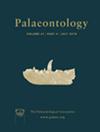阿尔卑斯山二叠纪早期最古老爬行动物化石中发现的锻造软组织
IF 2.3
2区 地球科学
Q1 PALEONTOLOGY
引用次数: 0
摘要
古戟龙(Tridentinosaurus antiquus)是最古老的爬行动物化石之一,也是意大利阿尔卑斯山西苏拉山期(早二叠世)极少数有软组织保存证据的骨骼标本之一。几十年来,该化石的保存和外观一直令古生物学家困惑不已,它的古生物学和系统发育地位也一直悬而未决。我们利用紫外线(UV)、三维表面建模、扫描电子显微镜与能量色散光谱(SEM-EDS)、微 X 射线衍射(μ-XRD)、拉曼光谱和衰减全反射傅立叶变换红外光谱(ATR-FTIR)对 T. antiquus 进行了重新分析,以确定身体轮廓的起源,并检验这是否代表有机保存的软组织残骸,进而揭示这只神秘原龙的重要解剖细节。然而,研究结果表明,构成身体轮廓的材料并非软组织化石,而是一种人造颜料,这表明身体轮廓是伪造的。我们的发现为这一神秘类群的有效性提出了新的问题。本文章由计算机程序翻译,如有差异,请以英文原文为准。
Forged soft tissues revealed in the oldest fossil reptile from the early Permian of the Alps
Tridentinosaurus antiquus represents one of the oldest fossil reptiles and one of the very few skeletal specimens with evidence of soft tissue preservation from the Cisuralian (Early Permian) of the Italian Alps. The preservation and appearance of the fossil have puzzled palaeontologists for decades and its taphonomy and phylogenetic position have remained unresolved. We reanalysed T. antiquus using ultraviolet light (UV), 3D surface modelling, scanning electron microscopy coupled with energy dispersive spectroscopy (SEM-EDS), micro x-ray diffraction (μ-XRD), Raman and attenuated total reflectance Fourier transformed infrared (ATR-FTIR) spectroscopy to determine the origin of the body outline and test whether this represents the remains of organically preserved soft tissues which in turn could reveal important anatomical details about this enigmatic protorosaur. The results reveal, however, that the material forming the body outline is not fossilized soft tissues but a manufactured pigment indicating that the body outline is a forgery. Our discovery poses new questions about the validity of this enigmatic taxon.
求助全文
通过发布文献求助,成功后即可免费获取论文全文。
去求助
来源期刊

Palaeontology
地学-古生物学
CiteScore
5.60
自引率
3.80%
发文量
43
审稿时长
6 months
期刊介绍:
Palaeontology publishes a wide variety of papers on palaeontological topics covering:
palaeozoology
palaeobotany
systematic studies
palaeoecology
micropalaeontology
palaeobiogeography
functional morphology
stratigraphy
taxonomy
taphonomy
palaeoenvironmental reconstruction
palaeoclimate analysis and biomineralization studies.
 求助内容:
求助内容: 应助结果提醒方式:
应助结果提醒方式:


